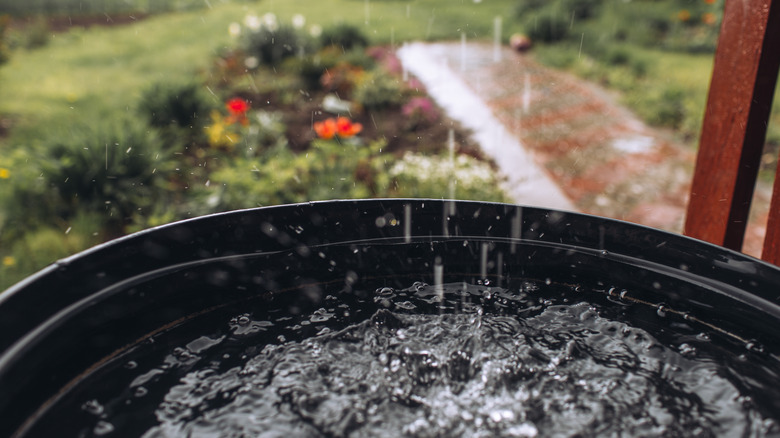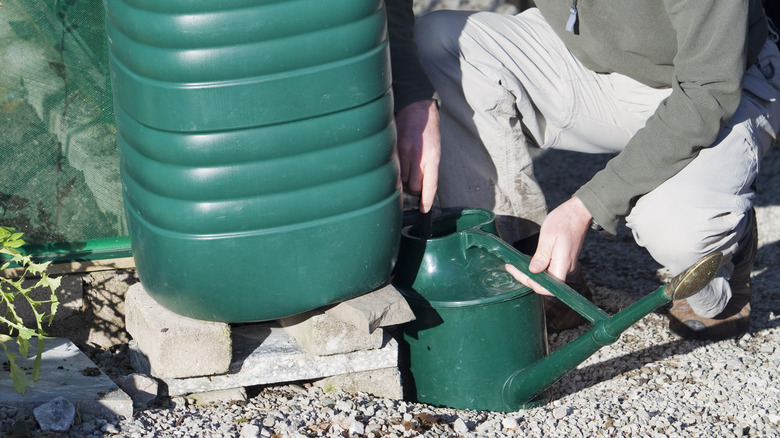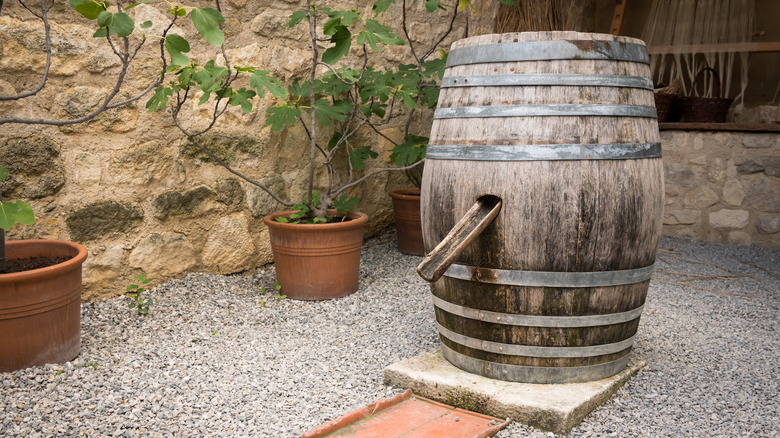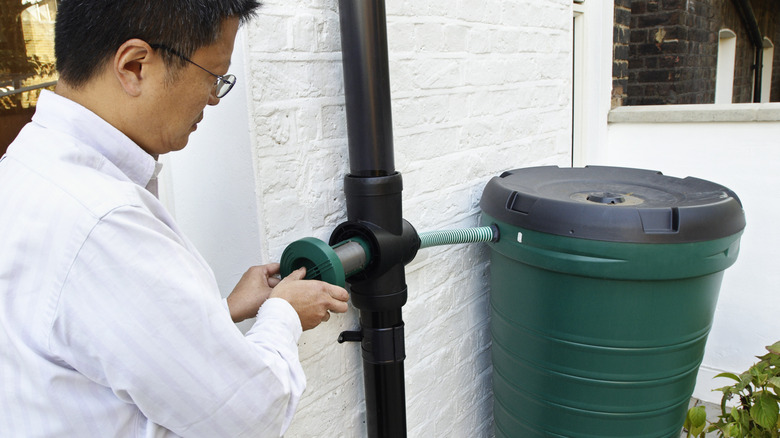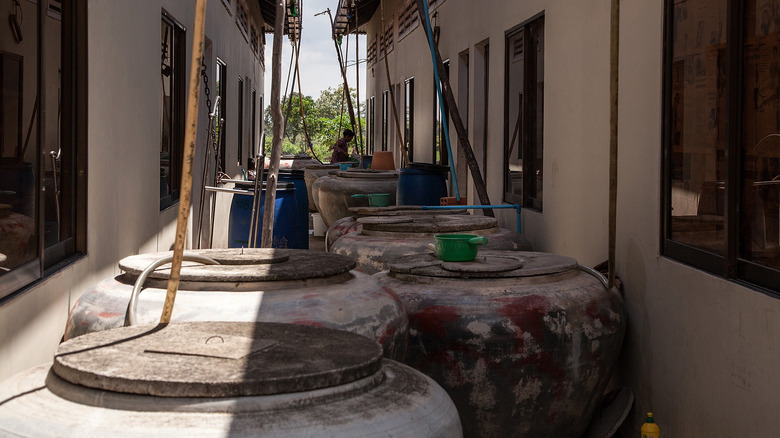4 Types Of Rain Barrels That Will Boost Your Garden And Conserve Water
According to the EPA, a rain barrel collects water from a roof, storing it for later use. Rising utility costs, combined with erratic weather patterns, mean that more and more people are looking to maximize all of the resources present in their homes and gardens.
The WWF referred to rain barrels as "one of the simplest and most effective methods of helping our planet". As well as saving you money on your water bill by harvesting fresh rainwater for your garden, rain barrels have added benefits for the environment. Moreover, increasing rainwater storage automatically means a reduction in runoff from your property.
Runoff is a major source of water pollution, according to National Geographic. Modern urban environments have a lot of waterproof surfaces — so instead of being intercepted by leaves and branches, then soaking into the soil, the rain flows across the asphalt and concrete surfaces, collecting whatever fertilizers, microplastics, particles, and chemicals are lying around on the roads and sidewalks. These lovely biohazards all mix together and end up flowing into streams, rivers, and ultimately the sea. By collecting as much of the rain that falls on your property as possible, and then using that water to keep your garden thriving, you can help mitigate this issue. By now, you should be convinced that you need a rain barrel at home — so here are four types of barrels to choose between.
Recycled plastic rain barrels
Rain barrels need to be durable. They are required to be sturdy and stalwart come literal rain or shine, and ideally to last as long as possible without springing a leak. According to Garden Gate, the most common choice of material for a rain barrel is plastic. This is because it embodies all of the requisite properties of a rain barrel, with the added benefit of being relatively cheap and easy to repair and, (whilst empty!) a plastic rain barrel is usually the most portable option, as they are quite lightweight.
Garden Watersaver advised seeking out food-grade barrels which are used as storage for soda syrup, sauces, and concentrated products for wine or beer production. Because these barrels cannot be reused and have to be disposed of at a cost to their users as industrial waste, they are often available for cheap or free. This can make for a very cost-effective recycled plastic water butt — along with a few other pieces of plumbing to make it work, of course.
If you don't want to take on the project of converting a barrel from one use to the other, but still like the idea of using recycled plastic, then there are ready-made water barrels made of 100% recycled resin available at most big-box stores.
Repurposed wood rain barrels
Before there was cheap plastic, the classic choice for rainwater storage would have been to reuse a wooden barrel — and, because of that rustic appeal, many still opt for wooden rain barrels today, according to Vertical Rain Garden. Many people simply enjoy the aesthetic of wooden rain barrels more than plastic ones.
However, wooden rain barrels are more expensive than plastic ones, they are inevitably heavier and therefore more difficult to move. Treehugger emphasized that, especially when sourcing a barrel from a local swap of some kind, it is imperative to make sure the barrel is sealed well. However, their lifespan is significantly shorter than plastic rain barrels. According to Kitchen Plot, the reputation of wooden rain barrels is that they over time they tend to rot and leak, as well as being hard to find.
It's important to realize that we are comparing wooden barrels which, according to Gardens All, will require a preservative treatment to last more than 7 years, to plastic barrels that conceivably could last 30 years with no intervention. Whilst that does definitely mean that wooden barrels require more maintenance — if you buy a good barrel and you're conscientious and thorough with your upkeep, most of a decade is still a good amount of time to enjoy a beautiful, eco-friendly garden feature.
DIY rain barrels
If your main motivation for getting a rain barrel is to save money, then the most cost-effective way to begin harvesting rainwater is with a DIY rain barrel. There are many different ways to construct a DIY rain barrel. Here are just a few things to consider, via the University of Nebraska Lincoln Extension:
Remember the weight — a 50-gallon water barrel will weigh over 400 pounds when filled. Not only does something that substantial require a steady base, but that base will need to be capable of supporting such a heavy load for months at a time over the years without sagging or subsiding.
Open- or closed-top — In terms of construction, the simplest way to go is to have an open-topped barrel, which is filled from a downspout via some kind of filter or strainer. However, In terms of water quality and longevity, Second Rain recommended a closed system, as this minimizes the chances of dealing with algae and mosquito problems down the line.
Where to overflow — Unless you are living in a desert or building a complicated system you will likely have some overflow from your rain barrel. To avoid flooding the area around your barrel, you ought to find an appropriate area for that overflow to be safely released so it doesn't impact your foundations!
Beyond the single barrel
Many people find that once they begin harvesting rainwater, they aren't satisfied with just one rain barrel, which can fill within the first moments of a downpour, notes Gardening Channel. This could be due to a desire to increase capacity and better cope with dry spells or to reduce wastage.
According to Climatebiz, an average rain barrel can only hold 50 gallons of water, but rather than trying to find a potentially expensive and heavy giant barrel, many preppers and permaculturists have created impressive systems of interlinked rain barrels.
According to Hammer & a Headband, their 5-barrel setup was enough to water their two raised beds all summer, but wouldn't suffice to quench the thirst of an entire garden of flowers. When deciding on a rain barrel system, it is worth calculating your water needs and evaluating whether there is enough space for that level of storage.
Finally, remember the points emphasized by Primal Survivor. Gravity is key to flow between barrels, so stagger their heights to allow water to flow freely in the directions you want. Also, remember that this is meant to be a system that lasts for years, so be mindful of sediment's potential to clog up pipes. Even the best filters will miss some particles, but they should mostly collect on the bottom of the barrel — simply set your interconnections at the top or the middle of your barrels and there won't be an issue!
